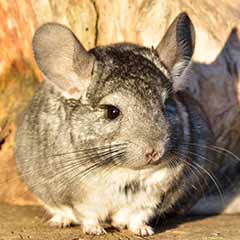
Short-tailed Chinchilla Conservation
Zoo New England has joined the AZA Chinchilla SAFE Program to help protect and recover some of the last remaining colonies of the Critically Endangered short-tailed chinchilla in Chile.



Zoo New England has joined the AZA Chinchilla SAFE Program to help protect and recover some of the last remaining colonies of the Critically Endangered short-tailed chinchilla in Chile.
Chinchillas were once found throughout the drier rocky foothills of the South American Andes. There are two closely related species, the short-tailed and long-tailed chinchilla. They are ‘richochetal,’ meaning they are experts at bouncing between boulders as they move across their rocky habitat. The chinchilla has the densest fur of all mammals that live on land, with around 20,000 hairs per square inch and 50 hairs growing from each follicle. They take care of their coats by dust-bathing, spinning in sand to help remove oils and keep their fur clean and dry. Unfortunately this incredibly soft fur led directly to the chinchilla’s rapid demise in the wild, as they became hugely coveted in the international fur trade.
In the wild, chinchillas were driven to the brink of extinction by hunting and commercial exploitation throughout their range, which once included Bolivia, Peru, Argentina, and Chile. The short-tailed chinchilla is now classified as Critically Endangered in Chile, where a very few isolated colonies persist in the country’s arid foothills. Mining activities now pose the greatest threat to remaining short-tailed chinchilla populations, while illegal hunting, infrastructure development, domestic animals, and climate change present additional perils. Only a few widely fragmented colonies still exist, all highly threatened by continued negative impacts.
AZA’s SAFE Chinchilla Program, with support from Zoo New England, is working with the National Zoo of Chile, the Chilean Ministry of the Environment, the Corporación Nacional Forestal (CONAF), and other in-country partners to verify locations of remaining chinchilla colonies and use the data to expand and connect protected areas for population recovery. The project is also collecting data on population genetics, developing and implementing a permanent monitoring program for short-tailed chinchilla colonies utilizing camera trap and acoustic recording methodologies, and guiding species recovery within the framework of Chile’s Chinchilla Recovery Plan.
SAFE Chinchilla includes the Programa Flora y Fauna de Huatacondo, an indigenous-led non-profit organization. Staff serve as field assistants and chinchilla colony monitors in their autonomous territory. SAFE Chinchilla is also working with the education and communications departments of the Zoológico Nacional de Chile and its AZA program partners to develop and implement conservation education activities and interpretation programs in communities near short-tailed chinchilla monitoring sites.
➤ Visit Stone Zoo to learn more about chinchillas and support our conservation efforts.
Banner photo by Nicolas Lagos



